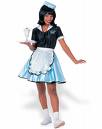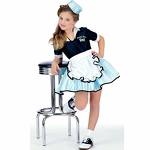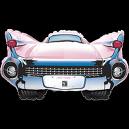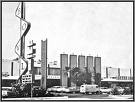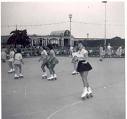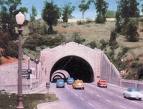Family Travel on America's Highways
From fifties
Contents |
[edit] Fun Car Facts
- Gas was $.18-$.23 per gallon
- In 1959 gas was $.25 per gallon
- Car sales from 1950-1959 totaled $6,665,800
- New cars cost $1,510.00 in 1950
- New cars cost $2,200.00 in 1959
- There were no cars built during the war
- [Bill Mitchell] was vice president of GMC and helped design the classic fin styled cars.
- [Harley Earl] started with the GMC company in the 1920's.
- Cars were used as the family taxi to get the husband off to the train depot for work and mom then turned into a bus driver to get the kids off to school. Moms often used their extra time in the day to go pick up laundry from the laundry-mat and run the family errands. Families began to eat out at the drive-in so mom didn't have to cook, families began their part in the car culture.
- The more cars that were bought and driven, the more new roads that had to be built.
- The more roads that were built, the more families that moved to [suburbia].
- Suburbia began the community center trends where the idea of shopping became a norm.
- The community center trends brought the need for clothes and cosmetics and daily trips in the car.
- The more people who drove to the community centers gave business owners the idea of major advertisement along the roadside, in their businesses windows, etc.
- The more cars that were driven, the more people dined out and it became the big craze for teens to hangout at the diner and cruise more often.
[edit] How World War II Affected the American Roadside
-
- At the end of [Worl War II], American's coming back from the war took on a new lifestyle. Families were moving into their newly built suburbia homes, and took to the roads for family vacations and fun, fun, fun.
- Many who lived on the roadside where people were headed found that business was picking up and reacted by remodeling and making new forms out of their existing buildings. Still with a little bit of home involved in the interior design and the addition of extravagant neon lights to the exterior, business began inflating. [Fuel stations], motels and restaurants were making sure they had the curb appeal to attract passing travelers. They were covered in large sheets of glass in the front to invite travelers in and it was common to have large blinking neon signs which brightly lit the offices and lobby's. In the Cafe' and hamburger stands were signs strategically spaced to display and advertise menus.
[edit] Why Americans Travel the Roads
-
- Every American at some point in time just wants to get away from the reality of every day life and be themselves. The road is a place to be free, there are no schedules to follow and you get to enjoy the company of your loved ones. The [1950s] came at the beginning of a new boom, when American's had overcome WWII, depression and we won the war, it was a time to hop in the car to have fun. This was a time when opportunity was endless for travelers.
- The 1950's was a time when families could travel and take family a vacation for a week or two trip or just for the weekend. There were roadside attractions[1] galore to fill the day of fun and excitement; from the [Vaudville] capital of the world, with its bicycling parrots and wrasslin' gators in Florida,to the [Hollywood Walk of Fame] in California. The fifties was filled with touristic junk food and the roadside attractions were loaded with empty cultural calories. Whether a family Buick was pointed toward Miami or [Niagara Falls], families were always ready to pull over for large quantities of food. All in all the occasion was the family vacation; the road trip, scenery, food and attractions. The family vacation was born during the postwar enthusiasm; it was a time of raging economy and there was lots of leisure time to pack the family into the car and drive. The automobile itself was a turn in America's boom- it was a dream of freedom on wheels and the feeling of people finally aloud to be themselves again. So many took the road with rock and roll as their ambiance in the background.
[edit] 1950's Hot Topics
[edit] Highway Bowling Alleys
-
- During WWII, the military installed [bowling alleys] at the bases as a source of recreation for the soldiers. When they returned home to America they were anxious to continue to bowl and it became very popular for families to do during free-time or on a road-trip. Prior to 1950's there were pinboys who sat at the end of the bowling alley to set up the pins after they were knocked and sent the balls back to the other end of the lane where the players would receive it, [pinboys] were payed five cents per pin string. Pinboys were replaced in the early fifties in America by automatic pinsetters. Bowling spiked the attention of teenagers for a local hang-out. The bowling alleys[2] had a great spread of food for all ages and offered cheap drinks, ice cream, lunch specials and cigars for the older men. Families spent the afternoon here just to relax and have fun.
- [The Professional Bowlers Association] became a popular sport to watch on television when it started being broadcast in 1958; in 1959 the association added a women's league.
[edit] Highway Drive-in-Theaters
-
- At the end of the 1940's, Drive-in-Theaters[3] averaged a total of one thousand attendants per year. Ten years later the average sky-rocketed to five thousand attendants per year. During the ten year span of the Drive-In's largest popularity, over five thousand indoor theaters closed down and attendance fell from seventeen thousand a year to twelve thousand.
- Many of the new drive-in-theaters were placed along the outskirts of town along the highways. People didn't just go to the drive-in to watch movies, they went their to have a good time even before the show started. Families showed up three hours prior to the movie when the gates opened to enjoy the recreation facilities [[4]]. They went to play a couple rounds of miniature golf, kids rode on miniature trains and played at the drive-ins personal park. Some theaters went as far as to offer pony rides, boat rides, held nightly talent shows and exotic animal shows prior to the beginning of the movie; the cover charge per car load was only a dollar.
- Most theaters had concession stands and served fried chicken, barbecue sandwiches, hamburgers, pizza and among other things.
- The smallest drive-in held 64 cars per showing and the second largest held 2,500 cars. The biggest one on record was in New York, they had a drive-in that held two thousand five hundred cars. It was a twenty eight acre lot which accommodated an indoor viewing area, had seating for 1,200 people with heat and air-conditioning, a playground, cafeteria, restaurant with full dinners and a shuttle train that would take you to various places through out the twenty eight acres.
[edit] Highway Roller Skating Rinks
-
- Roller skating[5] became a huge craze in the fifties after the invention of the boot skates rather than the metal strap on skates priorly used. The popularity of [roller skating] grew to the point where they were being built outside at amusement parks and on the roadsides of major routes throughout the states. Paying at the door prior to roller skating, gave you a rental coupon for skating. Males and females proceeded to separate counters and gave their tickets to an attendant behind the counter, in exchange of the customers shoes, the attendant would give them a pair of skates to rent during the session paid. Each session paid was a certain time frame of the day; sessions were held on the average of three hours. During each session they played a variety of popular songs and offered different types of skate themes The session would begin with an all skate, everyone was able to skate, the following sections would be followed by: backward skating only, trio skating, skating to the grand march, age distinguished skates and/or races.
- At the end of a skating session the lights in the rink would turn down low, thats when the skaters knew it was time for the couples skate to a range of slow songs. At the end of the day many skating rinks held private sessions. In the private sessions they held speed skating competitions, roller derby, roller hockey and the most popular one held was dance skating. Dance skating was a difficult sport when it came to the weight of the boot skates, the songs most commonly heard during dance skating was organ music (church like) and songs with a soothing sound. It varied in numbers per group for dance skating from solo to a five person team.
[edit] Obsessive Places to Visit Along the Highway
-
- After the war people were looking for amazing things to see, they wanted fun and excitement to remember their road-trips by. Eateries, diners, mini-golf and even gas stations created magnificent giant displays and turned even buildings into exotic things. In the east it was common to see large figures of Paul Bunyan and his giant blue ox Babe. Many found the tall tale of the super human with strength and speed to be a landmark of past loggers. Part of the tale about why his ox, Babe, was blue was because it was cold from where he was from so he was blue from being cold. Many giant things seen on the roadside were: people, animals, dinosaurs, food, things, and containers; they were made often out of fiberglass, concrete, wood, and/or metals.
- Hotels were turned into tee pees, gas stations were turned into giant tea pots and any thing else that would attract the travelers passing by. In the mid-century there were a few specific designs that were used, they would use the designs of googie, jet set, [populuxe], abstract shapes and lots of curves. Spanish styled buildings were beginning to develop as well in the more common areas along the road like at the train stations and bus stations to name a few; they were often enormous with statues, with marble settings, water structures and large areas of creative engravings of places and people.
- The idea of [outsider art] or [visionary environments] and [folk art] were large attractions of the roadside decor. People were making exotic things to share with the people on the road; houses, gardens, shrines made from recycled bottles were often seen and fairy tale parks with story book figures, gardens, playground equipment, and live barnyard animals were kept at various places to keep children entertained. Miniature villages were intensely put together with great detail for the awing of travelers and were landscaped with houses, running water, interactive trains and trolleys and buildings. Mini-villages often times also had petting zoo's and picnic groves for families to sit and have lunch together under the shady trees or by the water.
- There were many things for travelers to see, often seen were wax museums,rock caverns, things like Lucy the Elephant, the City of Mermaids, houses of mystery, dinosaur gardens, and amusement parks.
[edit] A List of some 1950's Roadside Attractions [[6]] (many are still being used today)
- Niagara Cavern, Minnesota, *Trimpers Rides, Ocean City, Boardwalk
- Lucy the Elephant, Margate, N.J., *City of Mermaids, Weeki Wachee, Florida
- House of Mystery, Goldhill, Oregon, *Rock City, Lookout Mountain, Tennessee
- Dinosaur Gardens, Ossineke, Michigan, *Corn Palace, Mitchell, S.D.
- Carlin's Amusement Park, Baltimore, Maryland, *Enchanted Forest, Route 40, Ellicott City
- Frontier Town, Ocean City, M.D., *Glenn Echo Park, Glenn Echo, M.D.
- Gwynn Oak Park, Gwynndale, Maryland, *Jolly Roger Amusement Park, Ocean City,
- Marshall Hall Amusement Park, Indian Head, M.D. Maryland
- Storybook Land, Woodbridge, Virgina, *Tolchester Beach, Kent County, Maryland
[edit] Polynesian Influences Along the Highway
-
- When the soldiers came back from the war they brought with them the [Polynesian influences] of aloha themed shirts and the south sea leisure. Motels, restaurants, and coffee shops picked up on the decor idea of the [tiki] huts, tiki bars and other cultural phenomenon. Along the influence of the Polynesian came the leisure of hula, hula hooping, surfing and beach music. At the end of the nineteen fifties Hawaii became a state and their culture influences grew even larger in the common states.
[edit] Mom and Pop Establishments
-
- When the straight and safe multi lane highways replaced well traveled towns on the wayside, the Mom and Pop businesses were restricted of their travelers because of designated off ramps and interchanges. It was too difficult to try and build motels and gas stations or cafe' stops between each town when they were already established. Franchises such as McDonald's and Holiday Inn swooped in to recover the available land between Main streets and the Interstate, cutting off any travelers who may have proceeded to where the Mom and Pop businesses were located.
- Soon there were interstates that connected from Chicago-to-Los Angeles that cut straight through replacing the already established leisure highways. Before interstates there were roads such as Route 66 that were the arteries of the United States, the towns major access to other states and cities.
[edit] Filling Stations
- [Filling stations], also known as service stations originally were established in pharmacies as a side business before the idea of cars was popular. The first purposeful gas station was built in St.Louis, Missouri in 1905. In 1915 gas stations were becoming more common and were found on the edge of the main streets and known as curbside stations. They later added shed stations in behind the new idea of gas pumps in the 1910's; in the 1920's filling stations pumped the gas but had no service bays, this began convenience store precursors; station chains were on the rise and began advertising their own gas station supplies to advertise and make more sales. At the end of the 1920's gas stations brought on the look of "English cottages," to have a more homey appearance and quaint charm in small towns or neighborhoods.
The 1920's to the 1940's gas stations used signage, logos, buildings and color schemes to attract their customers and relate them to other chain stations of the same design. In the late forties streamlining [moderne] and art deco was the remodeling choice by gas chains. Exotic architecture was used for curb appeal and to compete with other gas station chains. Some owners went as far as to build their store like airplanes, boats, tee pees and castles among others. Post war service stations developed into normally expected goodwill. Service employees were trained to do oil changes, basic mechanical repair, give tourists town information, hand out road maps, and give restaurant advice for the mom and pop oddities. They were to fuel the cars first, clean the windshields next, followed by lubrication checks, fill the tires, checked the battery and had to ask the customers if they wanted an undercoating for their cars to reduce rock damage to their undercarriage. Competition grew, many service stations gave away drinking glasses, trading stamps and car washes to advertise their businesses.
[edit] Coffee Shops
- The sprouting of [coffee shops] in America was brought on by European descent. They became havens for intellectuals, entertainers, writers, and political observers. [Googie] was the word used to define most coffee shops, from the architecture used to the formica and naugahyde fabrics, to the whimsy bright colors and urban organic expressionism. They used globe-like glasses for serving and earthenware mugs to hold their regular or decaf coffee.
Coffee shopsCoffee shops were the new abstract art, many of the colors used were bright and inviting. Oranges, reds, yellows, steel, plastic and other materials used flowed upward for a more traumatic effect and became more upbeat to match the American "personality". Liberated music was played and people were welcome to dance and read poetry while at the coffee houses.
Along the roadside restaurants like Denny's and McDonald's captured the trend for the details of using arches which is now linked to their businesses. The attraction of teenagers to the coffee house was very little until the offering of cheap pizza and they raised the beat of music a notch to the generational bebop and thumping of conga drums to the background music. Universities used coffee shops as a hangout; when found near a college, it was more likely to see fraternity paddles and wooden tables to the decor.
[edit] History of Mom and Pop Roadside Diners
-
- Diners have been apart of the American landscape for more than one hundred years. The
influence of the roadside culture came from the idea of the lunch wagons from the 18th and 19th century. Almost every aspect of America's history came from the lunch wagon, including cooking, dining out, popular culture, design, fashion and more.
- With the start of the diners came change in exterior looks. Stainless exteriors with large windows to look inward from the road and outward to the roads with air-conditioning, ventilation, and gorgeous lighting was the new thing. The designs came with the arrival of the space age rockets, and jet planes focusing on the upward and outward mobility; the new design was inspired by the liberated form of "form follows function." On the signs of the restaurant boards in bright neon lighting was the advertisements with lunch specials and homemade dessert specials.
- The bright and colorful menus were filled with the options of burgers for $.15-.18, hot dogs or fries were $.10-.20; shakes, root-beer floats, Pepsi, Cocoa-Cola, and Orange were $.10-.15 - there was also the choice of toasted grilled cheese sandwiches, the big melt (hot turkey sandwich with an open face on wonder bread topped with mashed potatoes, vegetables and gravy). Most freshly made desserts were apple pies or boysenberries, other desserts offered were Jello, pudding (vanilla, chocolate or tapioca), banana splits, and ice cream (vanilla, chocolate, strawberry).
[edit] History of Mom and Pop Roadside Motels
-
- Motels were an element of the roadside culture, prior to motels there were hotel taverns; above the bar and inns were tiny rooms for stage coaches and horse/carriage travelers or for people traveling by rail. When the invention of the cars came to be popular, car owners didn't want to park their cars in barns with the horses so car travelers decided to camp in the woods. It became to be so popular that land owners started to develop auto camps/motor courts on their property for travelers. Some auto camps were arranged in city parks and later added the amenities of picnic tables, fire-pits, showers, flushing toilets, sheltered eating, recreation areas and electrical hookups. Roadway signs were advertising the nearest auto camps on the way to town and many people found this a chance to make a little extra money and began charging travelers to stay on their property.
- Later people like moms and pops developed cabin camps so travelers could have privacy and get rid of the hobos who were trashing their property of the auto camps. Little wooden cabins were easier to maintain and were built big enough to hold a bed and usually a side stand. In the late 1920's the exterior image of the cabin camps became an artifact. Owners began creating Tee Pee styled cabins, adobe huts, miniature windmills, small villages, and fantasy motifs. Competition for getting travelers to stop began to rise immensely. The cabin camps were getting bigger and being filled with more amenities adding dressers, rugs, desks, pictures, lamps, and electric lights. Later the exteriors changed once again to keep up with the times and were replaced with streamlined and modern styles.
- Post war mom and pop [[7]]motels were transformed into single buildings with rooms that were attached to one another and gained major popularity. It was less expensive for owners to build and even easier to maintain. The exterior of the new motels were dressed in ornamentations and other odd gimmicks. The population of the motel roadside idea would shortly be picked up by corporate chains and then into national chain motels like the Holiday Inn.
[edit] The Affect of the New Interstates
- The first public highways appeared in 1916, a few years later they were revised in 1921 and in 1925 the government executed the plan of constructing America's ideal highwayshighways. In the summer of 1926 the designated U.S. 66 was destined to connect Chicago-to-Los Angeles, it was to be to east-west arteries of America. Route 66 was a highway that rapidly changed the connections of Lincoln highway, and the popular Dixie. The route had a rare diagonal course that connected hundreds of rural communities in Chicago, Kansas, Illinois, and Missouri. The highways were commonly used as transportation for farmers and the trucking industry. In the 1930's the new highways began to rival with the railroad company's for the shipping industry. The climates on the route from Chicago to the Pacific coast were favored compared to the highway routes in the north.
Route 66 made the history books when the military crossed the states in the early forties. In California alone the government spent approximately $70 billion for capital projects largely in the Los Angeles-San Diego area. After the war thousands took to the roads and many moved from the east to the southwest on route 66 to escape the harsh winters. Employment was provided by work relief from the New Deal on the construction of the new highways and the appearance of garages, diners and other tourists courts exploded.
- During WWII,post war and during the new popularity of highway travel the highways were taking a beating. The highway was falling apart and in bad shape, the capacity of cars on U.S. highway route 66 among others were beginning to diminish. During the war in Europe Army Captain Dwight D. Eisenhower fell in love of the idea of the autobahn. When Eisenhower became president in the 1950's he found the importance of making efficient highways a must. In 1953 Eisenhower pushed for the system of the highways across the U.S., the [Federal Aid Highway Act] was signed in 1956.
In 1957 the government arranged for clear signs to be posted on the highways and as there was many popping up throughout the country.
- [Interstate highways] were marked with the red, white, and blue shields with two digits.
- North and south highways had odd numbers
- East and west highways were even numbers
- West and south got the lower numbers
- East and north received the higher numbers
- Beltways and loops that were attached to the primary interstates used three digits
Before the interstate highways, travel in America was full of surprises, not the least of which were the offbeat roadside attractions that beckoned to motorist during the 1940's and 1950's. The project of the Interstate highways is the largest public works project in history.
[edit] Where Are The Historic Highways Now?
- Although many parts of highways like Route 66 [[8]] and Old [highway 101] can no longer be used, the are still visible to the sides of newly built roads. Many old highways are still being used today as [National Scenic Byways] and [All-American Roads]. To be apart of the National Scenic Byways, the roads must have some regional significance with at least on intrinsic qualities; scenic, natural, historic, recreational, archaeological, cultural or supply a unique travel experience. All-American Roads are considered to be the best of National Scenic Byways and meet the same criteria but have multiple intrinsic qualities of destination and an even better reason for travel unto itself like, Route 66, [Little Dixie highway], and [Lincoln highway] to name a few. There are are only 44 states in which have National Scenic Byways.
[edit] A list of Byways/Parkways/Historic Highways that are still used
- ====(Listed Alphabetically by State)====
- [Natchez Trace Parkway], Alabama
- [Alaska Marine Highway], Alaska
- [Coronado Trail Scenic Byway] & Historic Route 66, Arizona
- [Crowley's Ridge Parkway], Arkansas
- [Arrolyo Seco Parkway Scenic Byway (route 110)] & [Route 1], California
- [Colorado River Headwaters Byway], Cloroado
- Route 1http://en.wikipedia.org/wiki/U.S._Route_1 U.S Route 1, Connecticut
- [Brandywine Valley Scenic Byway], Delaware
- [A1a State Road], Florida
- [Russell Brasstown Scenic Byway], Georgia
- [International Selkirk Loop], Idaho
- Historic National Road [Historic National Road]& [Lincoln Highway], Illinois
- [Indiana National Road], Indiana
- [Loess Hills Scenic Byway], Iowa
- [Flint Hills], Kansas
- [Country Music Highway], Kentucky
- [Creole Nature Trail], Louisiana
- [Acadia Byway], Maine
- [Chesapeake Country Scenic Byway], Maryland
- [Copper Country Trail], Michigan
- [Edge of the Wilderness], Minnesota
- [Beartooth Scenic Byway], Montana
- [Little Dixie Highway of the Great River Road], Missouri
- [Natchez Trace Parkway], Mississippi
- Kancagamus Scenic Byway, New Hampshire
- [Billy the Kid Trail], New Mexico
- [Lake Tahoe: East Shore Drive], Nevada
- [Seaway Trail], New York
- [Blue Ridge Parkway], North Carolina
- [Native American Scenic Byway], North Dakota
- [Ohio River Scenic Byway], Ohio
- [Talimena Scenic Byway], Oklahoma
- [Hells Canyon Scenic Byway], Oregon
- [Seaway Trail], Pennsylvania
- [Cherokee Foothills Scenic Byway], South Carolina
- [Peter Norbeck Scenic Byway], South Dakota
- [Natchez Trace Parkway], Tennesse
- [Logan Canyon Scenic Byway], Utah
- [Connecticut River Byway], Vermont
- [Colonial Parkway], Virgina
- (I-90)[Mountains to Sound Greenway], Washington
- [Historic National Road], West Virgina
- [Great River Road], Wisconsin
[edit] References and Interesting Links
- <Arts: Architecture: Building Types: Iconic.<Roadside Attractions>[9]>
- <Coffee Shops>[10]>
- <Motels>[11]>
- <Entertainment>[12]>
- <Roadsides>[13]>
- <Route 66 A Concise History>[14]>
- <Highway History Bibliography>[15]>
- <Skating Rinks, Diners & Drive-ins, bowling alley, Motor Courts & Motels>[16]>
- <A Road Trip Back to the 50's>[17]>
[edit] Book Sources
- <American Route 66: Home on the Road>[Bernard, Jane,American Route 66: Home on the Road.1961.
- <Highways and the Reshaping of the American Landscape>[Gutfreund, Owen D., Highways and the ::Reshaping of the American Landscape.Twentieth-century Sprawl, 1963.
- <Romance of the Road>[Primeau, Ronald,Romance of the road: the.Bowling Green, OH: Bowling ::Green
- State University Popular Press, 1996
- <Route 66>[Quinta, Scott,Along Route 66.1941.

